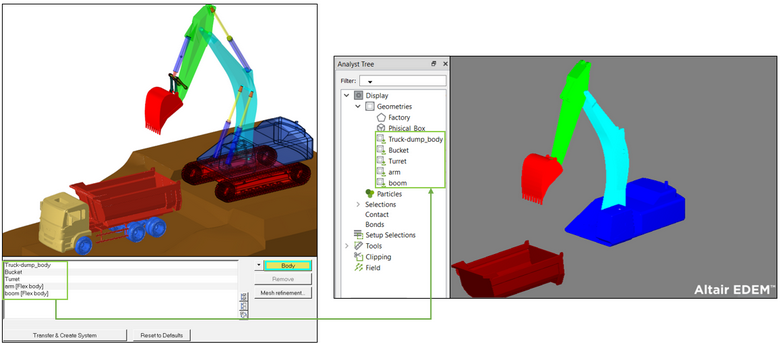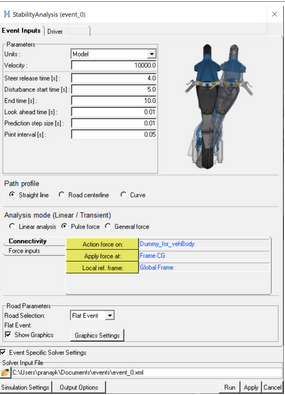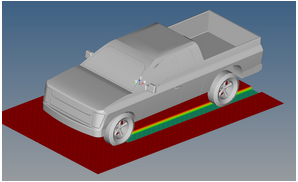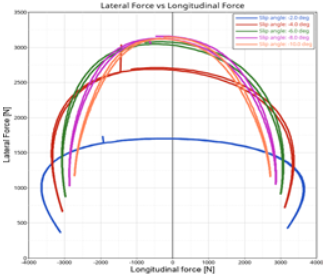Altair MotionView 2022 Release Notes
Altair Multi Body Solutions 2022 Release Notes
Highlights
- MotionView performance improvement
- EDEM coupling enhancements
- 2-wheeler stability event
- Tire soft-soil
- CDTire inflation pressure
- Tire test-rig - combined slip
- N-Post report
- Applus IDIADA proving grounds
- XenomatiX® scanned roads
More details about these features, additional enhancements, and resolved issues are described below.
New Features
- MotionView Performance Improvement
- MotionView core has been upgraded for improved model read and edit
times. Large assembly-based and systems-based models load up to 10 times
faster compared to previous versions. Similarly, exporting solver decks
of these models is also up to four times faster. There is a smaller
improvement time in reading CAD-based models.

Figure 1. - EDEM Coupling Enhancements
- MotionView/MotionSolve can interface with Altair EDEM, a
state-of-the-art bulk material simulation tool. EDEM is based on the
Discrete Element Method (DEM) that simulates and analyzes the behavior
of bulk materials, such as sand, granules, capsules, grass, rock masses,
and so on. In this coupling, the mechanical part is modeled in
MotionView and the bulk material is defined in EDEM. Using MotionView,
you can transfer geometries directly to EDEM and initiate the
co-simulation between MotionSolve and the EDEM solver. New to this
release is the transfer of geometry labels from MotionView to EDEM.
Graphics in EDEM that are connected to bodies in MotionView/MotionSolve
no longer need to be named component_0000,
component_0001, and so on. This helps
significantly in associating EDEM graphics with MotionView/MotionSolve
bodies.Note: This feature works only with EDEM 2022 or newer.

Figure 2.Furthermore, MotionSolve supports the Save/Load functionality for co-simulation with EDEM. You can save results in specified increments and restart at a saved point. The advantages are two-fold:- View intermediate results and adjust either the MotionSolve or EDEM model, if necessary.
- Co-simulations that were interrupted do not have to be restarted from the beginning, but can instead be restarted from a saved point in time.
- 2-Wheeler Stability Event
- A new event was added in MotionView to evaluate the stability of leaning
(especially 2-wheeled) vehicles. To help understand the weave and wobble
modes, the event can perform a Linear or Transient analysis, using a
pulse force or a general force defining the disturbance on the vehicle.
The vehicle can be simulated on different road surfaces. A report
session of the stability analysis includes:
- Linear analysis: Animation of the event and eigenvalues reported by MotionSolve for the model (.eig file).
- Transient analysis: Animation of the event, applied pulse or disturbance, steering wheel angle, FFT magnitude of the steer angle, roll angle, FFT magnitude of the roll angle, yaw angle, and FFT magnitude of the yaw angle.

Figure 3. Stability Event for 2-wheelers - Tire Soft-Soil
- MotionView/MotionSolve offers a new empirical tire model for soft soil
interaction. It offers a computationally efficient way to study the
dynamic behavior of vehicles traversing a compressible surface. The soil
is characterized by the well-known equations proposed by Bekker and
Wong. An additional graphic was implemented that visualizes the tire
sinkage into the soft ground. You are encouraged to use this tire model
first for initial design study before engaging in a more complex and
computationally expensive MotionSolve, EDEM, and PME FlexTire co-simulation.

Figure 4. Tire Soft Soil Post-processing in HyperView - CDTire Inflation Pressure
- A new field was added in the AutoTire panel to include the inflation pressure for CDTire models. With inflation pressure, you can simulate the effects of a tire blowout or flattening during a vehicle simulation.
- Tire Test-Rig - Combined Slip
- In MotionView, the Tire Test-Rig option simulates the combined slip
test. This test help evaluate the limits of the tire model in events
where it is subjected to multi-directional forces. A report session of
the combined slip test includes the model animation, tire force plots,
slip values, and cross and normalized plots.

Figure 5. Cross Plot: Lateral Force vs. Longitudinal Force - N-post Report
- A results report is available to simplify the post-processing of the
n-post test rig, assisting the analysis of vehicle vibrations or loads
evaluation. The report opens a list of pages and windows in a HyperWorks
session, displaying the animation of the event, vehicle body
accelerations, steering wheel accelerations, wheel forces, actuator
displacements, and actuator forces.Attention: Known issue - Overlaying of an n-Post report is not supported in this release.
- Applus IDIADA Proving Grounds
- Applus+ offers services and solutions in the testing, inspection, and
certification sector. At the IDIADA headquarters in Spain, there is a
370-hectares proving ground with various test tracks. The virtual
representations of these test tracks are available to be used as road
models in MotionView/MotionSolve simulations. The road files are
extracted from high resolution scans to capture all macroscopic
unevenness and irregularities of the real surfaces. The road files are
available through the Altair
Partner Alliance. You can accelerate their vehicle design and
development activities by integrating IDIADA Spain Virtual Proving
Ground (ISVPG) directly into your MotionView/MotionSolve model.

Figure 6. Applus IDIADA Spain Virtual Proving Ground - XenomatiX® Scanned Roads
- XenomatiX® measures and collects data of any road network or part of it, including local roads, highways, harbor quays, airport runways, or even off-roads. The data is measured using the solid-state lidar sensor XenoTrack and analyzed in XenoWare road software. A sample set of scanned road data from XenomatiX® are now available to be used as road models in MotionView/MotionSolve simulations. The road files are available through the Altair Partner Alliance.
- MotionSolve Online Community
- Altair hosts an online community of experts to share insights and collaborate with the wider CAE community. Part of this community includes forums and user groups where you can obtain answers to questions with support from other users. Click here to access the MBS Solutions community. MotionView/MotionSolve users are encouraged to participate in this forum to engage in online discussions, obtain insightful use cases, and access valuable resources to discover, learn, and grow as a MotionView/MotionSolve user.
- HyperWorks Startup Dialog
- In the Windows Start menu, individual client shortcuts are replaced by a single HyperWorks shortcut that prompts you to pick the client, profile, directory, or recent models and sessions.
Enhancements
- In MotionView, you can export a flex body to the solver deck without any connections.
- The flexible body preparation tool (Flexprep) reads OptiStruct FREE format statements in the FEM input file.
- The Preload tab in the SpringDamper panel is deactivated when stiffness or damping have non-linear properties.
- MotionView provides clearer error message upon failure of geometry transfer to EDEM. A warning message is displayed during the transfer of geometry to EDEM if the EDEM DLL path has a mismatched version.
- Export to CM Labs Vortex supports transferring rigid groups.
- New options to control Preload for SpringDampers are available.
- Using component names and units (cnames and cunits) are supported for user-defined outputs.
- MotionSolve added an optional attribute to the point-to-deformable-curve constraint (PTCV) that enforces the z-axis of the point marker to be either normal or tangential to the curve.
- MotionSolve relies on the industry-wide accepted Intel® Math Kernel Library (MKL) for its math routines. These routines are highly optimized and threaded for maximum performance. With this release, MotionSolve upgraded the version of the MKL from 2019.5 to 2020.
- MotionSolve’s Python-based API MSolve supports MQTT, a publish-subscribe network protocol that transports messages between devices.
- Tire deformation for CDTire and F-Tire can be visualized in HyperView.
- Aerodynamics force is added to the truck libraries.
- Fiala tires have the option to enter the tire friction (Mu) curve as a function of slip or force.
- MotionSolve supports F-Tire version 2021.4.
- MotionSolve supports OpenCRG version 1.2.
Resolved Issues
- mdl_batch fails launching HyperMesh when executed from a non-writeable location.
- Cell heights for tables in datasets were inadequate.
- Isolating entities on vehicle models breaks Autotire and AltairDriver.
- Application error is observed with degree of freedom check when Motion entity is unresolved.
- H3D file reference in exported MotionSolve solver deck (Python-based API) has changed to the absolute path.
- Application error while creating multiple systems using the Belt-Pulley system creation tool.
- An error is encountered during data MDL import relating to the number of records in Table Form.
- Export to Vortex Studio created an untitled folder under the user’s home directory.
- Flexbody ID assignment process on clicking run breaks shared definition.
- Application error when transferring model containing grounded bodies to Vortex.
- Initial conditions tab in Systems panel does not list bodies whose ICs are overridden by individual body IC assignment.
- Erroneous inertia properties are reported for certain surface-only graphics.
- Importing a system definition into a system with the same definition name results in an application error.
- An application error is encountered in the tab.
- In certain instances, a root-finding issue for CVCV constraint can occur.
- In some cases, using AltairDriver results in incorrectly stacked licenses.